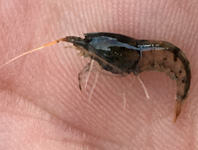Abstract
Numerous colonies of Eudistoma amanitum sp. nov. have been collected in Caribbean waters. The colonies resemble the groups of mushrooms from the Amanita genus and there are different color morphs. The discussion includes comparison with other species with similar shape.
References
Berrill, N.J. (1932) Ascidians of the Bermudas. Biological Bulletin, 62, 77–88.
https://doi.org/10.2307/1537145Breton, G. & Monniot, F. (2007) A new species of the genus Eudistoma (Ascidiacea, Polycitoridae) from Cape Verde. Avicennia, 19, 57–62.
Edgar, R.C. (2004) MUSCLE: Multiple sequence alignment with high accuracy and high throughtput. Nucleic Acids Research, 32, 1792–1797.
https://doi.org/10.1093/nar/gkh340Folmer, O., Black, M., Hoeh, W., Litrz, R. & Vrijenhoek, R. (1994) DNA primers for amplification of mitochondrial cytochrome c oxidase subunit I from diverse metazoan invertebrates. Molecular Marine Biology and Biotechnology, 3, 294–299.
Goodbody, I. (2000) Diversity and distributions of ascidians in the Pelican Cays, Belize. Atoll Research Bulletin, 307–326.
https://doi.org/10.5479/si.00775630.480.Goodbody, I. (2003) The ascidian fauna of Port Royal, Jamaica. I. Harbor and mangrove dwelling species. Bulletin of Marine Science, 73, 457–476.
Herdman, W.A. (1886) Report on the Tunicata collected during the voyage of H.M.S. Challenger during the years 1873-1876. P. II. In: Thompson, C.W. & Murray, J. (Eds.), Report on the Scientific Results of the Voyage of H.M.S. Challenger during the years 1873–1876, 1886, pp. 1–429.
Kott, P. (1990) The Australian Ascidiacea. Part 2. Aplousobranchia (1). Memoirs of the Queensland Museum, 29, 1–266.
Kumar, S., Stecher, G. & Tamura, K. (2016) MEGA7: Molecular Evolutionary Genetics Analysis Version 7.0 for Bigger Datasets. Molecular Biology and Evolution, 33, 1870–1874.
https://doi.org/10.1093/molbev/msw054López-Legentil, S. & Turon, X. (2005) How do morphotypes and chemotypes relate to genotypes? The colonial ascidian Cystodytes (Polycitoridae). Zoologica Scripta, 34, 3–14.
https://doi.org/10.1111/j.1463-6409.2005.00167.xMillar, R.H. (1975) Ascidians from the Indo-West Pacific region in the Zoological Museum, Copenhagen (Tunicata: Ascidiaces). Steenstrupia, 3, 205–336.
Millar, R.H. (1977) Ascidians (Tunicata: Ascidiacea) from the Northern and Northeastern Brazilian shelf. Journal of Natural History, 11, 169–223.
https://doi.org/10.1080/00222937700770131Monniot, C. & Monniot, F. (1972) Clé mondiale des genres d’Ascidies. Archives de Zoologie Expérimentale & Générale, 113, 311–367.
Monniot, F. (1972) Ascidies aplousobranches des Bermudes, Polyclinidae et Polycitoridae. Bulletin du Musée d’Histoire Naturelle, 61 (82), 949–962.
Monniot, F. (1983) Ascidies littorales de Guadeloupe. V. Polycitoridae. Bulletin du Musée d’Histoire Naturelle, Series 4a, 5 (4), 999–1019.
Monniot, F. & Monniot C. (2001) Ascidians from the tropical western Pacific. Zoosystema, 23 (2), 201–383.
Nei, M. & Kumar, S. (2000) Molecular Evolution and Phylogenetics. Oxford University Press, New York, 333 pp.
Oliveira, L.M., Gamba, G.A. & Rocha, R.M. (2014) Eudistoma (Ascidiacea: Polycitoridae) from tropical Brazil. Zoologia (Curitiba), 31 (2), 195–208.
Rambaut, A. (2009) FigTree version 1.3.1. Available from: http://tree.bio.ed.ac.uk/software/figtree/ (accessed 21 February 2018)
Rocha, R.M. & Bonnet, N.Y.K. (2009) Eudistoma clavatum sp. nov. (Tunicata: Ascidiacea: Polycitoridae) from Brazil. Marine Biodiversity Records, 2, e3.
https://doi.org/10.1017/S1755267208000031Rocha, R.M., Faria, S.B. & Moreno, T.R. (2005) Ascidians from Bocas del Toro, Panama. I. Biodiversity. Caribbean Journal of Science, 41, 600–612.
Rocha, R.M., Zanata, T.B. & Moreno, T.R. (2012) Keys for the identification of families and genera of Atlantic shallow water ascidians. Biota Neotropica, 12, 1–35.
https://doi.org/10.1590/S1676-06032012000100022Rocha, R.M., Guerra-Castro, E., Lira, C., Pauls, S.M., Hernández, I., Pérez, A., Sardi, A., Pérez, J., Herrera, C., Carbonini, A.K., Caraballo, V., Salazar, D., Diaz, M.C. & Cruz-Motta, J.J. (2010) Inventory of ascidians (Tunicata, Ascidiacea) from the National Park La Restinga, Isla Margarita, Venezuela. Biota Neotropica, 10, 209–218.
https://doi.org/10.1590/S1676-06032010000100021Ronquist, F., Teslenko, M., van der Mark, P., Ayres, D.L., Darling, A., Höhna, S., Larget, B., Liu, L., Suchard, M.A. & Huelsenbeck, J.P. (2012) MrBayes 3.2: efficient Bayesian phylogenetic inference and model choice across a large model space. Systematic Biology, 61, 539–542.
https://doi.org/10.1093/sysbio/sys029Sluiter, C.P. (1909) Die Tunicaten der Siboga Expedition. Part II: Die Merosomen Ascidien. Siboga Expedition, 56B, 1–112.
Smith, P.J., Page, M., Handley, S.J., McVeagh, S.M. & Ekins, M. (2010) First record of the Australian ascidian Eudistoma elongatum in northern New Zealand. New Zealand Journal of Marine and Freshwater Research, 41, 347–355.
https://doi.org/10.1080/00288330709509924Turon, X. & López-Legentil, S. (2004) Ascidian molecular phylogeny inferred from mtDNA data with emphasis on the Aplousobranchiata. Molecular Phylogenetics and Evolution, 33, 309–320.
Van Name, W.G. (1902) The ascidians of the Bermuda Islands. The Connecticut Academy of Arts and Sciences, 11, 325–412.
Van Name, W.G. (1921) Ascidians of the West Indian region and Southeastern United States. Bulletin American Museum of Natural History, 44, 283–494.
Van Name, W.G. (1945) The North And South American Ascidians. American Museum of Natural History, 84, 1–520.

